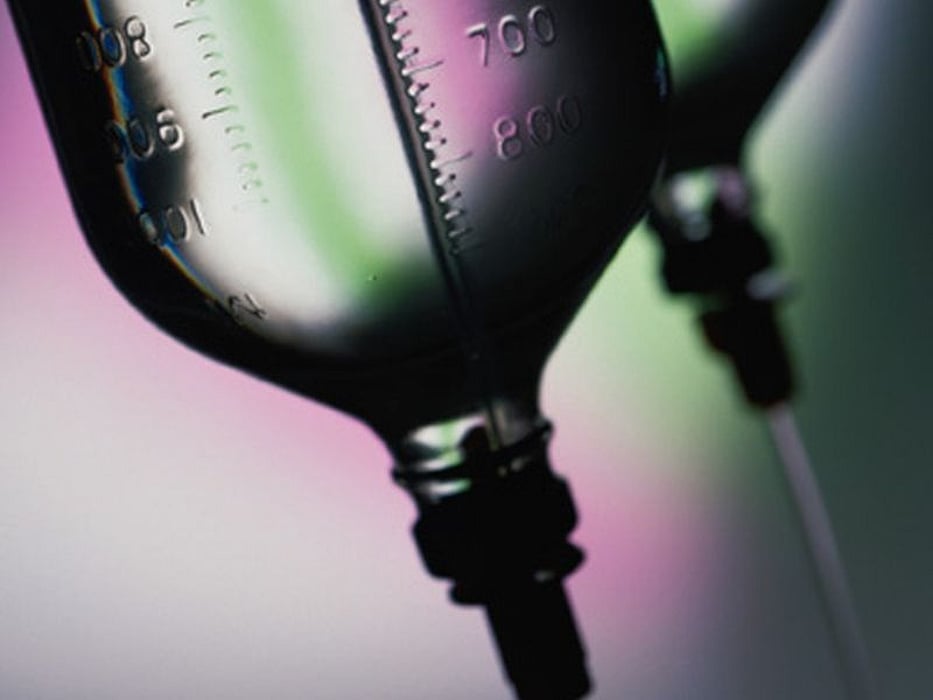More Athletes Are Getting Their Nutrition Through an IV. This Should Stop, Experts Say

WEDNESDAY, Aug. 17, 2022 (HealthDay News) -- Pro athletes appear to be regularly turning to intravenous (IV) nutritional drips to alleviate fatigue and speed recovery, despite the potential risks and without solid proof of any real benefit.
Normally, such needle-inserted drips are supposed to be reserved for treating a serious illness like anemia, or in an emergency situation such as severe dehydration.
Unless an exemption is granted for medical necessity, the World Anti-Doping Agency limits IV transfusions over 100 mL (3.38 ounces). Without such an exemption, the Olympics bars them.
But not all sports leagues have such restrictions, according to an editorial published Aug. 16 in the British Journal of Sports Medicine. And the result has been the rise of pre- or post-game "IV drip bars," in which sports doctors or nurses pump B and C vitamins, amino acids and/or electrolytes into athletes seeking a competitive edge.
"There is no clear evidence that this works," said study author Charles Pedlar. "And on the contrary, there may be negative effects."
A professor of applied sports and exercise science at St. Mary's University in Twickenham, near London, Pedlar points to a number of downsides: "By doing this athletes are putting themselves at risk of an infection; [there are also] unknown negative effects of pushing nutrients in their bodies to very high, supra-physiological levels; and the risk of violating an anti-doping test."
In "extreme circumstances," such drips may have a role, he noted.
But only two studies -- both inconclusive -- have investigated whether vitamin injections have any benefit for otherwise healthy individuals. And none has tracked the long-term effects -- good or bad -- that a regular use of drips might have on healthy athletes, Pedlar added.
That makes it "very hard to make a case for routine use of IV nutrition," he said.
Pedlar and his international colleagues say it is not clear just how widespread the practice is.
But the authors -- who variously work in professional athletic training centers, hospitals and universities -- noted there is plenty of anecdotal evidence suggesting that IV nutritional drips have become routine in the sports world.
"Companies are offering this service directly to athletes promising some kind of positive outcome, such as enhanced hydration status and faster recovery," Pedlar said.
In large part, the drips fall into what he described as a legal "gray area," with restrictions varying by sport and what's contained in a drip. He called on sports governing bodies to steer athletes away from the practice.
And Pedlar offered this advice to athletes and their handlers: “Stick to food, consumed orally."
That advice is strongly seconded by St. Louis-based nutrition consultant Connie Diekman, former president of the Academy of Nutrition and Dietetics.
"As a sports dietitian, the comments I would always hear were 'how do I get a competitive edge, how do I recover more quickly, what can allow me to perform better?'" she noted. "And unfortunately those comments would often lead athletes to the 'magic' [fix]. The perception with IV nutrition is that nutrients can be absorbed more quickly, thus -- in theory -- helping the athlete perform or recover faster."
The question is: Does IV nutrition do that?
"Thus far, the research is limited," Diekman said.
Plus, there's reason to think that the practice carries potential risk on the one hand, or is a complete waste of time and money on the other, she added.
Diekman pointed to evidence suggesting that risky cross-nutrient interactions may be exponentially stronger because IV-ingested nutrients bypass the stomach and liver and enter the bloodstream directly.
"The stomach and liver work to control absorption and filtering of toxins, [and] using an IV misses that step leading to the potential for toxicity," she explained.
And, Diekman added, if the body doesn't require as much of a nutrient as the IV contained, it will excrete the excess. The result is "expensive urine," she added.
Diekman advises athletes to focus first on food for their nutritional needs, developing a plan with a sports dietitian to fuel for best performance and recovery.
"Finally, know what supplements and drugs are banned by your sport," and check with your trainer or dietitian before taking anything, she concluded.
More information
The University of Wisconsin School of Medicine and Public health has more about athletes and nutrition.
SOURCES: Charles Pedlar, PhD, professor, applied sports and exercise science, St. Mary's University, Twickenham, London, U.K.; Connie Diekman, MEd, RD, sports dietitian/food and nutrition consultant, St. Louis, and former president, Academy of Nutrition and Dietetics; British Journal of Sports Medicine, Aug. 16, 2022
Was this page helpful?
Related Posts
Omicron Hits Younger People, But Less Likely to Bring Long Hospital Stays
MONDAY, Feb. 7, 2022 (HealthDay News) -- Omicron COVID-19 patients are younger...
Shingles Won’t Raise Risk for Dementia: Study
THURSDAY, June 9, 2022 (HealthDay News) -- If you've survived a painful bout of...
Weight-Loss Surgery Could Bring Weaker Bones to Teens
TUESDAY, June 13, 2023 (HealthDay News) -- Weight-loss surgery can have a lot of...
